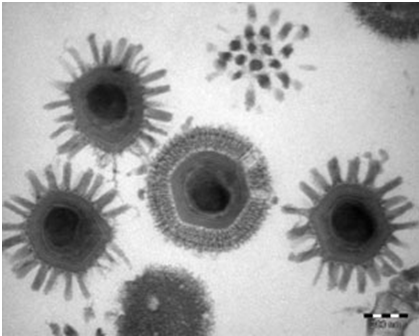Viruses are infectious agents that have a simple acellular structure that is mainly made up of a protein coat or capsid and a nucleic acid genome which can either be DNA or RNA. Some viruses also have envelopes (which are lipid-containing outer membranous layer that surround the nucleocapsid in some viruses) while others lack them, and are thus generally known as naked viruses.
Viruses with envelopes are known as enveloped viruses. Viruses are unique group of microorganisms that are composed of several chemical molecules or structures that are vital to their development and replication within a particular host cell. These chemical compositions of viruses include the viral proteins, viral envelopes, viral glycoproteins and viral genomes; and they form the integral parts of mature viruses.
- Viral proteins: Viral proteins are important components of a virus because they serve as the main antigenic determinants or epitopes of an infecting virus. The viral proteins bind specifically to the receptor molecules on host cells, and this facilitates their penetration or entry into the cell. Viral proteins form parts of the viral capsid or protein coat which serves to protect the nucleic acid genome of the infecting virus. This protective function prevents any external damage to the viral nucleic acid either by enzymes that readily hydrolyze or destroy the viral genome. Generally, the viral proteins provide and maintain the structural integrity or symmetry of viruses.
- Viral enzymes: Viruses like other organism contain enzymes (which are proteinous in nature) that facilitate their development and replicative processes within their host cell. These enzymes which include reverse transcriptase (RT) and RNA polymerase enzymes play critical role in the replication process of viruses that harbour them, even though the enzymes may have little or no function in the protein coat of the virus.
- Viral genomes: The nucleic acid genome of a virus is either DNA or RNA. No virus contains both DNA and RNA as its nucleic acid genome. Viral nucleic acid genome is important because it is what contains the genetic information necessary for the replication of an infecting virus within a host cell. The genome of a virus can assume several orientations. The genome of a virus can either be circular or linear in structure. Some are double-stranded (ds) while others are single-stranded (ss). The viral genome can also be segmented or non-segmented; and while some RNA-containing viruses have genomes with negative-sense strands (-) others have genomes with positive-sense (+) strands. Some RNA-containing viruses have genomes that are ambisense – becausethey have a partial genetic coding sequence in the positive-sense as well as in the negative-sense. Arenaviruses are examples of viruses with ambisense genomes. There is a great variation in the nucleic acid genome of a virus depending on whether the virus is a DNA-containing virus or an RNA-containing virus. Also, the genome size of DNA viruses (which is usually in the range of 3.0-370 kbp) is different from the genome size of RNA viruses (which is usually in the range of 7-30 kb). All animal viruses including those that infect humans have a dsDNA genome. The only exception is parvoviruses (in Parvoviridae family)which have ssDNA genome. All RNA viruses that infect animals and humans have ssRNA genome with the exception of reoviruses (in Reoviridae family) which have dsRNA genome.
- Viral glycoproteins: Viral glycoproteins are viral molecules that comprises of proteins and carbohydrates which are attached together. They are mainly found on enveloped viruses; and viral glycoproteins are virus-encoded in that they are generated by the viruses themselves. Viral glycoproteins form the surface glycoproteins of enveloped viruses and they aid in the adsorption of enveloped viruses to specific molecules on the surface of the host cell. Naked viruses lack viral glycoproteins.
- Viral envelopes: Some viruses are known as enveloped viruses because they contain envelope while other are referred to as naked viruses because they lack envelopes. Enveloped viruses acquire their envelopes (which are lipid-like) through the cytoplasmic membrane of their host cell by a budding process. And this occurs during the maturation and release of the virus from the host cell. Since they contain lipids, enveloped viruses are sensitive to lipid-solvents, ether and other organic solvents unlike naked viruses that lack lipid-envelopes and are resistant to treatment with organic solvents.
References
Acheson N.H (2011). Fundamentals of Molecular Virology. Second edition. John Wiley and Sons Limited, West Sussex, United Kingdom.
Alan J. Cann (2005). Principles of Molecular Virology. 4th edition. Elsevier Academic Press, Burlington, MA, USA.
Alberts B, Bray D, Johnson A, Lewis J, Raff M, Roberts K and Walter P (1998). Essential Cell Biology: An Introduction to the Molecular Biology of the Cell. Third edition. Garland Publishing Inc., New York.
Barrett J.T (1998). Microbiology and Immunology Concepts. Philadelphia, PA: Lippincott-Raven Publishers. USA.
Black, J.G. (2008). Microbiology: Principles and Explorations (7th ed.). Hoboken, NJ: J. Wiley & Sons.
Brian W.J Mahy and Mark H.C van Regenmortel (2010). Desk Encyclopedia of Human and Medical Virology. Elsevier Academic Press, San Diego, USA.
Brooks G.F., Butel J.S and Morse S.A (2004). Medical Microbiology, 23rd edition. McGraw Hill Publishers. USA.
Cann A.J (2011). Principles of Molecular Virology. Fifth edition. Academic Press, San Diego, United States.
Carter J and Saunders V (2013). Virology: Principles and Applications. Second edition. Wiley-Blackwell, New Jersey, United States.
Champoux J.J, Neidhardt F.C, Drew W.L and Plorde J.J (2004). Sherris Medical Microbiology: An Introduction to Infectious Diseases. 4th edition. McGraw Hill Companies Inc, USA.
Dimmock N (2015). Introduction to Modern Virology. Seventh edition. Wiley-Blackwell, New Jersey, United States.
Dimmock N.J, Easton A.J and Leppard K.N (2001). Introduction to modern virology. 5th edition. Blackwell Science publishers. Oxford, UK.
Discover more from Microbiology Class
Subscribe to get the latest posts sent to your email.





